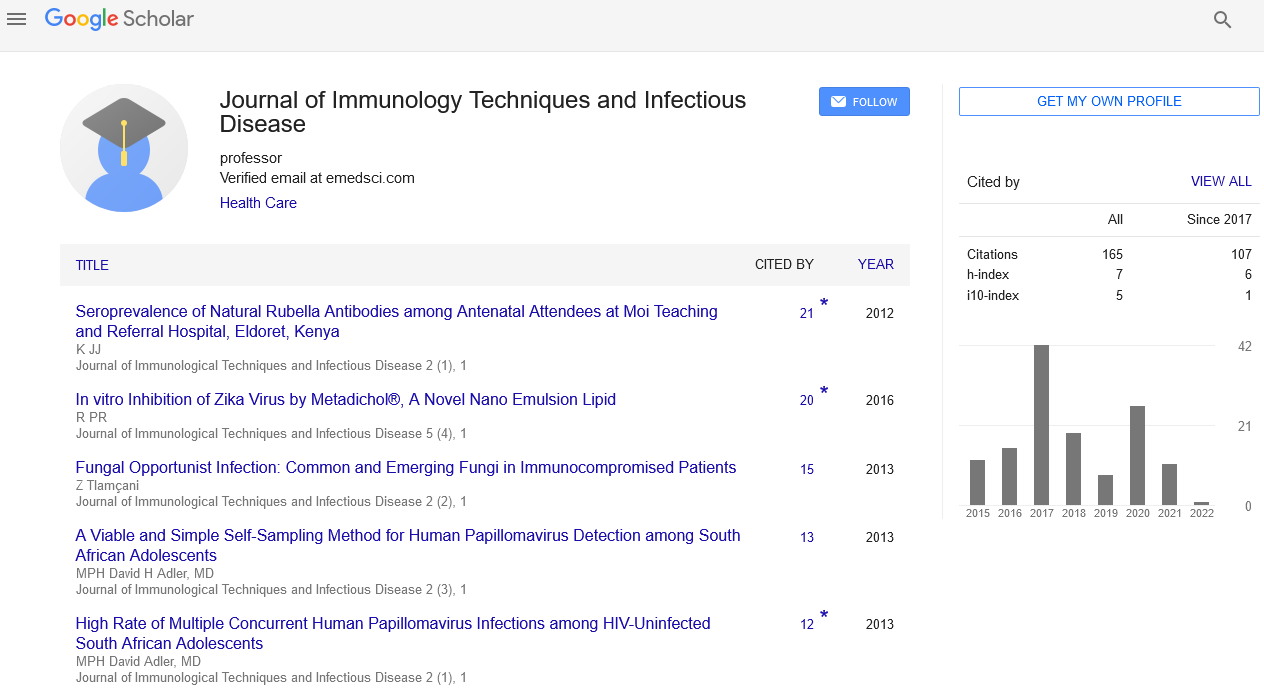Perspective, J Immunol Tech Infect Dis Vol: 12 Issue: 2
Clinical Manifestation of Meningococcal Disease and Its Treatment
Xilin Sia*
1Department of Epidemiology of Microbial Diseases, Yale School of Public Health, New Haven, USA
*Corresponding Author: Xilin Sia,
Department of Epidemiology of Microbial
Diseases, Yale School of Public Health, New Haven, USA
E-mail: xilinsia@gmail.com
Received date: 29 May, 2023, Manuscript No. JIDIT-23-105432;
Editor assigned date: 31 May, 2023, PreQC No. JIDIT-23-105432 (PQ);
Reviewed date: 14 June, 2023, QC No. JIDIT-23-105432;
Revised date: 21 June, 2023, Manuscript No. JIDIT-23-105432 (R);
Published date: 28 June, 2023, DOI: 10.4172/2329-9541.1000343.
Citation: Sia X (2023) Clinical Manifestation of Meningococcal Disease and Its Treatment. J Immunol Tech Infect Dis 12:2.
Description
Meningococcal disease is a potentially life-threatening illness caused by the bacterium Neisseria meningitidis. It is characterized by inflammation of the protective membranes surrounding the brain and spinal cord, known as the meninges. Meningococcal disease can progress rapidly and lead to severe complications, including meningitis and septicemia. Epidemiology of meningococcal illness was studied using whole genome sequencing.
Causes and transmission
Neisseria meningitidis, or meningococcus, is a bacterium that exists in various forms, known as serogroups. The most common serogroups associated with meningococcal disease are A, B, C, W, X, and Y. These bacteria are transmitted from person to person through respiratory droplets, such as coughing, sneezing, or close contact with an infected individual. It is important to note that while many people carry the bacteria in their throat or nose without experiencing illness (a condition known as asymptomatic carriage), they can still transmit it to others. Bacterial meningitis is brought on by bacteria that enter the bloodstream and go to the brain and spinal cord. However, bacterial meningitis can also develop when bacteria enter the meninges directly. An ear or sinus infection, a skull fracture, or very infrequently some procedures could be the reason for this.
Pneumococcus streptococcal in the United States, this bacterium is the most frequent cause of bacterial meningitis in newborns, young children, and adults. It more frequently results in sinus, ear, or pulmonary infections. This infection may be prevented with a vaccination.
Meningococcal meningitis is bacterial meningitis that is brought on by this bacterium. When these bacteria penetrate the bloodstream, they can cause meningococcal meningitis in addition to the typical upper respiratory infection they commonly cause. Teenagers and young people are the major targets of this extremely contagious virus.
Symptoms and clinical presentation
The symptoms of meningococcal disease can vary depending on the age of the individual and the stage of the infection. Common symptoms may include sudden onset of high fever, severe headache, neck stiffness, nausea, vomiting, sensitivity to light (photophobia), and a characteristic rash that may be petechial (small red or purple spots) or purpuric (larger patches of bruising). In infants, the signs and symptoms may be more subtle and can include fever, irritability, poor feeding, and a bulging fontanelle (soft spot on the baby's head).
Complications
If left untreated meningococcal disease can lead to severe complications, including meningitis (inflammation of the meninges), septicemia (blood infection), and potentially permanent disabilities such as hearing loss, neurological damage, and limb amputations. The disease can progress rapidly, with a high risk of mortality if not diagnosed and treated promptly.
Prevention
Vaccination: Vaccination is the most effective way to prevent meningococcal disease. Several vaccines are available targeting different serogroups. The Meningococcal Conjugate Vaccine (MCV4) offers protection against serogroups A, C, W, and Y, while the serogroup B vaccine (MenB) provides specific protection against serogroup B. Vaccination is recommended for infants, adolescents, college students, military personnel, and individuals at increased risk due to certain medical conditions or travel to high-risk areas.
Good hygiene practices: Practicing good hygiene, such as regular hand-washing with soap and water, covering the mouth and nose when coughing or sneezing, and avoiding close contact with infected individuals, can help reduce the spread of meningococcal bacteria. Chemoprophylaxis in certain situations, such as when an individual has been in close contact with an infected person, antibiotic prophylaxis may be recommended to prevent the spread of the bacteria.
Conclusion
Prompt recognition of the symptoms and timely medical intervention are important for the management of this disease. Vaccination, good hygiene practices, and antibiotic prophylaxis in specific situations are key preventive measures. By increasing awareness and taking necessary precautions, we can collectively work towards reducing the incidence and impact of meningococcal disease, ultimately protecting the health and well-being of individuals at risk.
 Spanish
Spanish  Chinese
Chinese  Russian
Russian  German
German  French
French  Japanese
Japanese  Portuguese
Portuguese  Hindi
Hindi 
